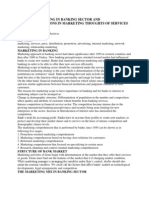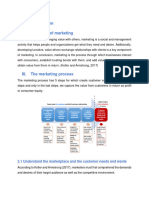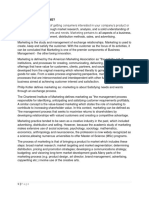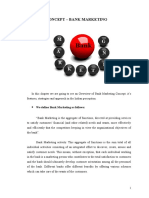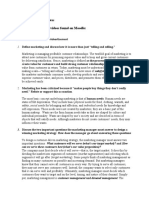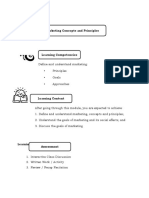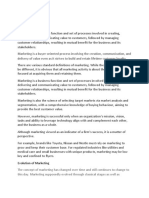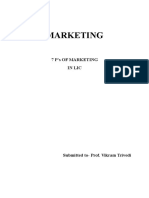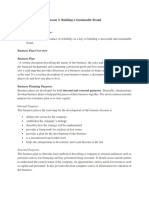Bank Marketing
Bank Marketing
Uploaded by
paulin patrick noukam ngoboCopyright:
Available Formats
Bank Marketing
Bank Marketing
Uploaded by
paulin patrick noukam ngoboOriginal Description:
Original Title
Copyright
Available Formats
Share this document
Did you find this document useful?
Is this content inappropriate?
Copyright:
Available Formats
Bank Marketing
Bank Marketing
Uploaded by
paulin patrick noukam ngoboCopyright:
Available Formats
Course title: BANK MARKETING
Lecturer: Dr. MBOH SUSANNASH.
INTRODUCTION.
Question: why would you prefer a particular product over another?
Marketing touches our daily life’s choice. We wake up with radio and T.V by our side, advertising
a trade fair at a sport complex. Then we brush our teeth with different brands of toothpaste
(Colgate, etc..), drink some café, martinal etc. while driving a car of different marks (Toyota,
Mercedes etc.). Marketing interferes with our daily life and influences our decision especially
when it comes to our choices of brands and products.
CHAPTER1: MARKETING FUNDAMENTALS AND KEY CONCEPTS RELATING TO
THE BANKING INDUSTRY.
1. DEFINITION OF MARKETING.
Marketing can be referred to aa process of planning and executing the concept, pricing, promotion
and distribution of ideas, goods and services to create exchanges that satisfies the needs and wants
(objectives) of individuals and organizations. This definition encompasses 05 key elements of
marketing:
It is a planning process
It involves the conception, pricing, promotion and distribution of something
Its object can be either tangible or intangible.
It works through exchange processes.
DEFINITION OF KEY CONCEPTS
Planning process:
Marketing involves an ongoing process of developing plans, executing them, monetizing their
result and modifying them when need arises.
Conception, pricing and distribution of a product.
Marketers have to design, develop product, fix prices and promote product. This involves the use
of the marketing mix
Targeted towards individual and organizational objectives
The objective of marketing is the satisfaction of individual and organizational objectives. I.e. their
needs and wants.
The effects of banks processes and systems on customer satisfaction/financial performance.
Course title: BANK MARKETING
Lecturer: Dr. MBOH SUSANNASH.
It works through an exchange process
Marketing only occurs when a person in need of a product is capable of offering something of
value to satisfy marketer’s objectives. i.e. exchange must be possible. What then is the meaning of
marketing? Many people only think of a marketing as selling and promotion. Selling and
promotion though important, are merely aspects of marketing. The aim of marketing is to know
and understand the customer so well that, the product offered fits their needs and sell itself.
Hence marketing can be defined as: a social and managerial process by which individuals and
organizations obtain what they want through creating and exchanging “products” and
“value” with others.
TYPES OF MARKETING
A group of potential customers can be considering as a type of market e.g. the financial market,
product market etc…
Different types of markets have different managing styles and philosophies to guide the marketing
management. One of the philosophies that lead to long-term marketing success is the marketing
concepts. It is the basis for decision making and a guide for effectively managing resources.
Therefore, marketing is an organizational philosophy that influences and direct all operations. i.e.
everyone is involved.
THE FOUR PILLARS OF MARKETING CONCEPTS.
1. CUSTOMER ORIENTATION.
Marketing oriented firms believe their financial objectives will be best attained by identifying
their target market and responding to their needs and wants. Good products and quality
services form repeated purchases. They create satisfied customers who eventually becomes faithful
and loyal customers.
2. PROFIT ORIENTATION.
Profit oriented firms maintain a balance between customer satisfaction and profit goals.
3. TOTAL COMPANY EFFORTS.
Marketing concepts must become the philosophy of the entire organization. It is important to
integrate and coordinate the activities of all the employees based on people who work for the
business are the business.
4. SOCIAL RESPONSIBILITY.
Social responsibilities are important for banks as they provide a quasi-public service. Banks are
expected to play an active role in social affairs. “consumerism demands that a business starts
out with the needs, wants and values of the customers. It demands that business base their
reward on their contribution to the customer’s satisfaction.
The effects of banks processes and systems on customer satisfaction/financial performance.
Course title: BANK MARKETING
Lecturer: Dr. MBOH SUSANNASH.
OTHER CONCEPTS RELATED TO BANKING SERVICES.
1. Products oriented concept.
The means that the bank is concerned with its products itself, the quality of the product.
THEODORE LEVITT held that since consumer’s buying habits change, banks should not
define their businesses in terms of current product being sold, but in terms of rapidly
changing consumer needs that are being met.
2. The selling oriented concept.
This can be described in terms of sales efforts. Sales oriented banks convince customers to do what
they want (different from marketing oriented concepts)
3. Customer oriented concept.
This concept follows the marketing oriented concept where in the firms search to meet the needs
and wants of the customers.
CUSTOMER EXPECTATIONS FOR QUALITY SERVICES.
They can be categorized into five areas.
Responsiveness.
Customers expects bank staffs to be willing to take care of their needs and wants, prompt and
accurate resolution for any errors that might occur.
Assurance.
Customers expects bank staffs to be courteous, competent, helpful and polite.
Empathy.
Customers expect bankers to show a genuine interest for their needs and wants, and also, to
apologize for any inconveniencies.
Reliability.
Bank staff must always work to maintain their credibility and dependency.
Tangibility.
Attention to details makes an impression on customers e.g. clean office.
CHAPTER 2: BANK MARKETING DEVELOPMENT PLAN.
A bank marketing development plan is a written document that summarizes the observation of a
market behavior. (before engaging into a market, it is important to know the behavior of the
market. i.e. the needs of the customers, the competitors and the market situation). It is worth noting
here that, a bank marketing plan the financial institution to promote its products and services that
meets the target users. This process requires research, commitment, times and analysis. This
The effects of banks processes and systems on customer satisfaction/financial performance.
Course title: BANK MARKETING
Lecturer: Dr. MBOH SUSANNASH.
process also helps the bank to focus on its priorities when marketing its product and services.
Hence it is a valuable process that can greatly contribute to the profitability and stability of the
bank.
1. Elaboration of a marketing plan
Benefits of elaborating a marketing plan
The elaboration of a marketing plan can be beneficial in 5 different ways namely:
Identification of a target market and understanding of how your product meets the needs of the
customers.
Identification of competitors and the impression of your targeted customers about the strength and
weaknesses of your competitors.
Position your brand, product and services so that your target customers better off or different from
that of your competitors.
Set specific and measurable goals, timeframe for the marketing of your products.
Design a strategy to reach your targeted audience including messages channels and tools Design a
strategy to reach your targeted audience including messages channels and tools you have to use.
2. Stages for the elaboration of a marketing plan
The basic stages for the elaboration of a bank marketing plan are:
An industry review
A conduct of market research
Definition of market and customer profile.
A conduct of a SWOT analysis
A study of the existing competition
Setting of marketing goals and objectives
An outline of the marketing strategy
Setting of the marketing budget
Continuous update of the marketing plan
Implementation of the marketing plan.
Conducting an evaluation and control on the marketing plan
3. THE DEVELOPMENT OF A SITUATION ANALYSIS (SIAN).
A SIAN answers the first marketing planning question of where are we now. It is a formal
systematic procedure that helps banks understand their current situation (the weakness and
strength). Hence the critical SIAN function is to help management know what needs to be done.
The effects of banks processes and systems on customer satisfaction/financial performance.
Course title: BANK MARKETING
Lecturer: Dr. MBOH SUSANNASH.
CONDUCTING A SITUATION ANALYSIS.
Essential research must be conducted inn a SIAN. Information is imperative here for setting up
objectives, measuring and evaluating.
SIAN must be objective and thorough in order to compare their banks position with its competitors.
Give employees an understanding of the importance of their cooperation.
SIAN comprises of 4 main elements namely:
1. INTERNAL ANALYSIS
This consist of renewing the banks performance and current situation. In this case, the marketer
should renew the following:
Employees. That is,
o Number of employees at various level
o Measuring of employee’s performance
o Management of employee’s relation
Finance (money).
o Income level of the bank
o Profit before tax
o Capital
o Total deposits
Systems.
o Number of banks branches
o ATM access points
o Available computing system
o The level of technology
Customer loyalty with the bank.
o Number of deposit accounts
o Volume of personal loans
o Volume of corporate loans
o Focus on investment
o Other banking services.
The SIAN should answer questions such as:
What is the size of the industry?
Is the industry growing or shrinking?
Does the industry have a good market penetration nationally and internationally?
Which are the leading firms in the industry?
What is the market share of the these leading banks?
The effects of banks processes and systems on customer satisfaction/financial performance.
Course title: BANK MARKETING
Lecturer: Dr. MBOH SUSANNASH.
The SIAN should also include a review of current marketing mix strategies, banks market shares
and feedback from market surveys.
2. MACROECONOMIC FACTORS ANALYSIS.
Macroeconomic factors affect the marketing plan and consist of:
The economic environment.
Bank marketers need to know the economic environment in which they operate in order to
understand economic trends and make projections on the future of the economy. Economic
environment analysis should include:
o Employment trends
o Business circles
o Inflation level
o Retail, commercial and construction activities.
Demographic environment
In this case, the bank marketers will need to design the bank population in the market area. There
is an important relationship between the market population and the financial service offered.
Variables such as age groups, education level, income level and geographic distribution of the
population are considered.
Social and cultural environment.
The consist of a change in consumer’s values and lifestyle that may cause their needs and desire
for the products and services to change.
Political environment
The political situation of a country greatly affects the banking industry.
Regulatory and legal environment.
This reflects the effects of regulations and legislations on the banking sector e.g. the regulations
of e-payment within the CEMAC zone has a great impact on the consumption of banking
products and services.
Technological factors
Technological advances bring about new technologies for delivering financial services (fintechs)
Natural environmental factors.
Natural environmental factors are worth considering for any unforeseen circumstances that might
provoke a crisis situation.
The effects of banks processes and systems on customer satisfaction/financial performance.
Course title: BANK MARKETING
Lecturer: Dr. MBOH SUSANNASH.
Microeconomic environment factors
The microeconomic factors consist of:
Customers
Bank marketers must understand their customers demographically, know their needs and
preferences regarding bank products and services. This can be achieved through surveys as well
as customer buying behavior and attitude towards the bank.
The market
This implies the size, growth, geographic distribution, demographic and potential profitability of
the market targeted by the bank.
Competition
There is a need to compare your performance to that of your competitors. Bank marketers need
information on:
o Comparative operating statistics. i.e. comparing financial statement with that of your
competitors.
o Comparative market share. It is an indicator of bank competitive strength. There is need to
develop primary data using market research surveys, banks corporate with each other to gather the
information they need.
NB; having the biggest market share doesn’t mean the best.
o Comparison of the market strategies. In this case, the bank marketers go to the market and see
what their competitors are doing, how they use the marketing mix.
Market intermediaries.
Bank marketers should have knowledge on location, address, accessibility, timeliness, pricing and
courtesy concerning their intermediaries. E.g. MOMO agents as financial intermediaries.
The general public.
Bank marketers must be sensitive to internal and external that might be interested or affected by
their marketing plan.
NB: employees should be informed about the marketing plan and must be trained to execute the
plan at various level.
SWOT (Strength, Weakness, Opportunities, and Threats) ANALYSIS OF THE BANKING
INDUSTRY
Considering that the Strength and weaknesses of a bank have been analyzed above, we are going
to look at the opportunities and threats of the banking sector.
The effects of banks processes and systems on customer satisfaction/financial performance.
Course title: BANK MARKETING
Lecturer: Dr. MBOH SUSANNASH.
Opportunities
o Significant growth potentials
o New technologies
o Large customer base
o Young and dynamic personnel
Threats
o Political instability
o Economical changes
o Stagnant savings
o High level of customer indebtedness
o Repayment difficulties
o Poor money laundry screening
o Financial and non-financial laws in the banking system
o New technologies, increasing substitute products into the market.
FINDINGS OF THE SIAN
The final step of the SIAN is to summarize your findings. The summary should be a factual
statement, covering banks main opportunities and problems. The results of the findings of the
SIAN acts as a basis for the bank to review its objectives, strategies and tactics.
NB: it is worth noting that, SIAN merely consist of a SWOT (Strength, Weakness, Opportunities
and Threats) and PESTLE (Political, Economic, Social, Technology, Legal and Environmental)
analysis.
CHAPTER 3: MARKETING STRATEGY.
Marketing strategy is a plan of action for identifying and analyzing a target market in order to
develop a marketing mix to meet the needs of the targeted market. Marketing strategies are
developed from the marketing objectives as derived from the marketing plan (see chapter 2). The
results from the SIAN acts as a basis for the bank to reveal its objectives, strategies and tactics.
Hence it can be said that, marketing objectives are a qualitative measure of what is to be achieved
by the marketing activities. One of the main purpose of designing and implementing a marketing
strategy is to ensure a sustainable competitive advantage for the bank.
A sustainable competitive advantage implies that, your competitive are unable to copy your brand
of product and services.
TAF: create a marketing mix of a bank of your choice.
The effects of banks processes and systems on customer satisfaction/financial performance.
Course title: BANK MARKETING
Lecturer: Dr. MBOH SUSANNASH.
The components of a marketing strategy.
An effective marketing strategies must:
Reflect on the overall objectives of the bank
Be coordinated with the bank’s functional areas
Contributes to the achievements of the bank’s marketing and organizational goals
HOW TO CONCCIEVED AN EFFECTIVE MARKETING STRATEGY
To design an effective marketing strategy, the bank marketers must outline how the bank will
achieve its objectives. Hence, emphasis should be made on:
Market penetration (target market)
Product development e.g. the promotion of new deposit schemes, new insurance, insurance
through electronic cards…
JUSTIFICATION OF THE CHOICE OF A MARKETING STRATEGY.
Selected marketing strategies must be justified by four factors namely:
Sustainability
Acceptability
Feasibility
Affordability.
1. Suitability of a marketing strategy.
o The targeted environment must portray a potential growth, developed technologies and
infrastructures suitable for the marketing strategy.
o The outlined marketing strategy must be capable of branding the image of the bank.
o The outlined marketing strategy must meet up with the expectation of the customer, hence
ensuring customer satisfaction.
o Also, the selected marketing strategy must generate better returns.
TAF: understand the product life cycle.
2. Acceptability and feasibility.
For a marketing strategy to be acceptable and feasible, it must fulfill the following:
o Ensure high returns
o There must be positive stakeholder’s reaction
o The marketing strategy must reveal low risk
o There must be an availability of resources i.e. labor, funds, competence etc.
Once a marketing strategy is accepted, it must be implemented. Thereafter, the evaluation and
control process. The marketing evaluation and control process consist of:
The effects of banks processes and systems on customer satisfaction/financial performance.
Course title: BANK MARKETING
Lecturer: Dr. MBOH SUSANNASH.
o Establish performance standards
o Evaluate the actual performance with respect to established performance.
o Ensure a corrective action if necessary.
TAF: segmentation and positioning strategies.
CHAPTER 4: PRODUCT STRATEGY AND NEW PRODUCT DEVELOPMENT
STRATEGY.
1. A product: A product is a key element in the marketing mix. This is because, it is the bank’s
reason of existence. All banks are in the industry to satisfy customer’s needs through their
product.
2. Distribution or positioning strategy: This implies making a product available when and
where the market needs it.
3. Pricing strategy: this implies making the product available at a price that is attractive to the
customers and profitable to the seller.
4. Promotion strategy: this communicates to the market the potential benefits of the product
based on the product design and the products attributes.
WHAT IS A PRODUCT?
According to PHILLIP COTLER, “a product is anything that can be offered to the market
for attention, acquisition, use of consumption that might satisfy a need or want. All banking
products and services are considered as products. However, from a marketing point of view, a
product has five attributes:
Core products
Generic products
Expected products
Augmented products
Potential products.
1. Core products: This is a product that has the potential benefits that the customer is buying it
for.
2. Generic product: this is a product with a broad spectrum but provides the benefit needed by
the customer.
3. Expected product: this is a product that has the features customers assume will be part of their
needs.
The effects of banks processes and systems on customer satisfaction/financial performance.
Course title: BANK MARKETING
Lecturer: Dr. MBOH SUSANNASH.
4. Augmented product: this is a product with specific characteristics and benefits that help
differentiates the bank’s products from that of competitors. Banks products are augmented by
the level and quality of the services provided as well as the reputation of the bank.
5. Potential products: this implies all the modifications the products might undergo in the future.
SERVICE VS PRODUCT: DIFFERENCE.
A service is different from a product in that, it is any act of performance that one party offers to
another. There are different types of product industry such as: Health, Transport, Finance and
Education industry.
Services have characteristics that creates problem for marketers such as: intangibility,
inseparability, variability and perishability. Hence marketing a service is very different from
marketing a product.
PRODUCT MIX STRATEGIES.
The product mix strategies consist of:
- Product expansion
- Product contraction
- Product modification and product life cycle.
1. Product expansion: this implies adding new product to an existing product. It deepens the
product line. E.g. the digitalization of consumption credit for amounts less than 100 00frs.
2. Product contraction: this implies shrinking the product line by eliminating products that
contributes little or no profit and concentrating the bank’s resources on products that will
generate high profits.
3. Product modification: this implies improving on the product’s design either redesigning or
repackaging in order to increase the sales of the products. It is important to continually is
important to continually modify a product so as to respond to the changing consumer
preferences.
4. The product life cycle strategy: this shows the pattern of the sales at each stage of the life
cycle of a product. Some product takes off quickly as they enter the market and suddenly
disappear in the market while others revive after the decline stage. Product lifecycle has five
stages namely:
The takeoff/initiation/introduction or incubation stage.
Growth stage
Saturation stage
Decline stage
The effects of banks processes and systems on customer satisfaction/financial performance.
Course title: BANK MARKETING
Lecturer: Dr. MBOH SUSANNASH.
NEW PRODUCT DEVELOPMENT.
Products turns turn to be more profitable in the growth stage. While some banks develop new
product, others develop product and service delivery systems that are new to the market. These
operators are usually large banks with substantial research and development budget.
NEW PRODUCT DEVELOPMENT STAGES
There 08 common steps in developing a new product in any sector of activity namely:
Exploration and idea generation stage (conception of the idea)
Product screening
Concept testing
Business analysis
Product development
Test marketing
Implementation and commercialization
Evaluation and control.
Effective monitoring and control systems are essential for every banks to take corrective actions
when needed and gain additional knowledge that will facilitate the introduction of the next new
product.
The effects of banks processes and systems on customer satisfaction/financial performance.
You might also like
- BBA Project FinalDocument54 pagesBBA Project FinalDiddu Perfect100% (1)
- Elements of Marketing BookDocument110 pagesElements of Marketing BookBabasab Patil (Karrisatte)67% (3)
- Marketing of Financial ServicesDocument43 pagesMarketing of Financial ServicesSaiparesh Walawalkar100% (1)
- Fama (1995) - Random Walks in Stock-Market Prices PDFDocument6 pagesFama (1995) - Random Walks in Stock-Market Prices PDFMartin McflinNo ratings yet
- Unit IvDocument8 pagesUnit IvDr.P. Siva RamakrishnaNo ratings yet
- Introduction of Marketing Mix PNBDocument7 pagesIntroduction of Marketing Mix PNBNishant_g90% (1)
- Project On Big BazaarDocument108 pagesProject On Big BazaarIsaac XavierNo ratings yet
- Devki Final ProjectDocument52 pagesDevki Final Projectshiv infotechNo ratings yet
- Marketing Strategy of Commercial BanksDocument8 pagesMarketing Strategy of Commercial BanksBinodBasnetNo ratings yet
- Directorate of Distance Education: Sikkim Manipal University 2 Floor, Syndicate House Manipal - 576 104Document24 pagesDirectorate of Distance Education: Sikkim Manipal University 2 Floor, Syndicate House Manipal - 576 104Sachin JainNo ratings yet
- Marketing Management Unit-1 Class NotesDocument34 pagesMarketing Management Unit-1 Class Noteskpsingh6763No ratings yet
- Marketing Mang Notes Mba 1ST Sem - Aktu Unit 1Document18 pagesMarketing Mang Notes Mba 1ST Sem - Aktu Unit 1RUBA NASIMNo ratings yet
- Market Segmentation in Banking SectorDocument56 pagesMarket Segmentation in Banking SectorArchana Pawar78% (18)
- Bank Marketing Mix New Stretegy in TodayDocument10 pagesBank Marketing Mix New Stretegy in TodayMirjana StefanovskiNo ratings yet
- MB0046 OkDocument12 pagesMB0046 OkKumar GauravNo ratings yet
- Marketing Management-1Document62 pagesMarketing Management-1Pratiksha TiwariNo ratings yet
- Service Marketing in Banking Sector andDocument4 pagesService Marketing in Banking Sector andmarium_20505582No ratings yet
- Marketing managementDocument10 pagesMarketing managementanshika.work28No ratings yet
- Marketing 5Document88 pagesMarketing 5motima4516No ratings yet
- Draft Asm1 5033Document10 pagesDraft Asm1 5033Nguyễn NhiNo ratings yet
- Tutorial 1 & 2: 1. What Is Marketing?Document2 pagesTutorial 1 & 2: 1. What Is Marketing?Sha HerNo ratings yet
- Chapter - 1Document53 pagesChapter - 1Ruksana MohammadNo ratings yet
- MarketingDocument35 pagesMarketingAmirah FuadNo ratings yet
- Chapter-: Recent Marketing Strategies of Commercial Banks in Kerala-It's Impact and ImplicationsDocument62 pagesChapter-: Recent Marketing Strategies of Commercial Banks in Kerala-It's Impact and ImplicationsSir GodwishNo ratings yet
- Marketing Handout 01Document4 pagesMarketing Handout 01gcuusmanNo ratings yet
- Assignment On Marketing ManagementDocument28 pagesAssignment On Marketing ManagementFisseha KebedeNo ratings yet
- AssignmentDocument6 pagesAssignmentibsaashekaNo ratings yet
- Principles of Marketing NEWDocument159 pagesPrinciples of Marketing NEWfisahabirhane16No ratings yet
- Advanced Module 1Document92 pagesAdvanced Module 1David MorelNo ratings yet
- Market Segmentation in Banking SectorDocument56 pagesMarket Segmentation in Banking SectorMauro VieiraNo ratings yet
- Customer Satisfaction-ICICI Bank-Priyanka DhamijaDocument85 pagesCustomer Satisfaction-ICICI Bank-Priyanka DhamijaVarun GuptaNo ratings yet
- Chapter 1-3 Review Notes MGN 2210Document8 pagesChapter 1-3 Review Notes MGN 2210KaiNo ratings yet
- Marketing in BankingDocument5 pagesMarketing in BankingSnehasish SinghamahapatraNo ratings yet
- Marketing of Financial ServicesDocument40 pagesMarketing of Financial ServicesJaiswal Manoj0% (1)
- Marketing of Bank Products and Services: Emerging Trends: DR - Rakesh.RDocument7 pagesMarketing of Bank Products and Services: Emerging Trends: DR - Rakesh.RAnsley MaureayeNo ratings yet
- Marketing ManagementDocument328 pagesMarketing Managementlatsek50% (4)
- Principles of Marketing Module 1Document14 pagesPrinciples of Marketing Module 1Kathleen Mae NatividadNo ratings yet
- Steps of Marketing Process Understanding The Marketplace and The Customer Needs and WantsDocument3 pagesSteps of Marketing Process Understanding The Marketplace and The Customer Needs and WantsZelica ZamielNo ratings yet
- Module 1 - Marketing Principles and StrategiesDocument13 pagesModule 1 - Marketing Principles and StrategiesCESTINA, KIM LIANNE, B.No ratings yet
- Module 1 - MarketingDocument15 pagesModule 1 - MarketingNeelam RathodNo ratings yet
- MM Version 1Document593 pagesMM Version 1Prateek ChaudharyNo ratings yet
- Marketing Principles and StrategiesDocument22 pagesMarketing Principles and StrategiesMarie Nicole SalmasanNo ratings yet
- JournalDocument14 pagesJournalShriya ParmeshwaranNo ratings yet
- Ei Ei Zin MKTDocument11 pagesEi Ei Zin MKTAung Kyaw Soe SanNo ratings yet
- Marketing ManagementDocument19 pagesMarketing Managementemiljose046No ratings yet
- Rashmi Srivastav RRDocument82 pagesRashmi Srivastav RRniteshsinghnikku60No ratings yet
- Akhand SipDocument21 pagesAkhand SipParakh SinghNo ratings yet
- Marketing: 7 P'S of Marketing in LicDocument48 pagesMarketing: 7 P'S of Marketing in LicMaria NunesNo ratings yet
- MB0046 Q1: Discuss The Different Marketing Concepts With Its Merits and DrawbacksDocument2 pagesMB0046 Q1: Discuss The Different Marketing Concepts With Its Merits and DrawbacksRahul SharmaNo ratings yet
- MarketingDocument66 pagesMarketingBharat Makkar100% (1)
- Group Assignement: Student Name: RAINIDAVIDA Zo Herimanjato Maurille ID CM0007Document15 pagesGroup Assignement: Student Name: RAINIDAVIDA Zo Herimanjato Maurille ID CM0007Zou HerimanjatuNo ratings yet
- MM Short MaterialDocument24 pagesMM Short MaterialThippana GomathiNo ratings yet
- Digital Marketing GuideDocument110 pagesDigital Marketing GuideCHRISTINE JANE FLORESNo ratings yet
- Definition: The Art and Science of Choosing Target Markets and Getting, Keeping, RowingDocument8 pagesDefinition: The Art and Science of Choosing Target Markets and Getting, Keeping, RowingRand EmmadiNo ratings yet
- MMPC006Document32 pagesMMPC006210010502041.mgtNo ratings yet
- The Entrepreneur's Toolkit: Time Management, Networking, and More for New BuisnessFrom EverandThe Entrepreneur's Toolkit: Time Management, Networking, and More for New BuisnessNo ratings yet
- Textbook of Urgent Care Management: Chapter 25, Marketing OverviewFrom EverandTextbook of Urgent Care Management: Chapter 25, Marketing OverviewNo ratings yet
- Winning With Strategic Marketing: Driving Success for Startups and Small BusinessesFrom EverandWinning With Strategic Marketing: Driving Success for Startups and Small BusinessesNo ratings yet
- Theme: What International Strategy To Implement For A Successful Business?Document4 pagesTheme: What International Strategy To Implement For A Successful Business?Abdourahman JpNo ratings yet
- Pad215 Slide Topic1Document20 pagesPad215 Slide Topic1Afifah HananiNo ratings yet
- KIM ABSL Smallcap Fund 2205Document21 pagesKIM ABSL Smallcap Fund 2205arjietNo ratings yet
- Hong Kong Tax Alert: 21 September 2020 2020 Issue No. 13Document6 pagesHong Kong Tax Alert: 21 September 2020 2020 Issue No. 13gir botNo ratings yet
- 6-Business Plan OverviewDocument6 pages6-Business Plan OverviewBianca VacunawaNo ratings yet
- Sanjay GuptaDocument3 pagesSanjay Guptaajalalimba21No ratings yet
- 2 - Marks MaterialDocument2 pages2 - Marks Materialkms195kds2007No ratings yet
- Company ProfileDocument21 pagesCompany ProfileMADHUSMITA PANDITROYNo ratings yet
- A Study On Customer Satisfaction Towards Nilgiris Super MarketDocument43 pagesA Study On Customer Satisfaction Towards Nilgiris Super MarketBenivel Stephen71% (7)
- DR CR Le LeDocument7 pagesDR CR Le LeKANGOMA FODIE MansarayNo ratings yet
- Week 5 Chapter 11Document6 pagesWeek 5 Chapter 11CIA190116 STUDENTNo ratings yet
- Tax-09-Input-Vat 3Document10 pagesTax-09-Input-Vat 3ayubangeralddave26No ratings yet
- Green Library Checklist Sustainable Buildings, Equipment, and Management - OCM DatasheetDocument8 pagesGreen Library Checklist Sustainable Buildings, Equipment, and Management - OCM Datasheetlydiangrey88No ratings yet
- MarketLineIC - PayPal Holdings Inc - Profile - 201021Document44 pagesMarketLineIC - PayPal Holdings Inc - Profile - 201021Divyang SaxenaNo ratings yet
- The Caterpillar 6 Sigma JourneyDocument45 pagesThe Caterpillar 6 Sigma JourneyAulia100% (1)
- Venture Capital and Private Equity Contracting: An International PerspectiveDocument58 pagesVenture Capital and Private Equity Contracting: An International PerspectiveAli LatifNo ratings yet
- CHAPTER 2 Human Resource Planning (HRP) Human Resoucre Planning (HRP)Document9 pagesCHAPTER 2 Human Resource Planning (HRP) Human Resoucre Planning (HRP)Belle Mendoza100% (1)
- Handbook On Accounting Procedures For RD InstitutionsDocument131 pagesHandbook On Accounting Procedures For RD InstitutionsLaldinliana VarteNo ratings yet
- JD 236 FINAL EXAM - FuerzasDocument28 pagesJD 236 FINAL EXAM - Fuerzascarl fuerzasNo ratings yet
- Aaconapps2 00-C91pb1aDocument17 pagesAaconapps2 00-C91pb1aJane DizonNo ratings yet
- A Summer Internship Project ReportDocument20 pagesA Summer Internship Project ReportAaryan kadamNo ratings yet
- Bussiness PlanDocument15 pagesBussiness PlanKudakwasheMuneriNo ratings yet
- Payment Schedule & Pricing Details of Prabha Aikyam: Rs.4250/-Per SQ - FTDocument1 pagePayment Schedule & Pricing Details of Prabha Aikyam: Rs.4250/-Per SQ - FTBibek DeyNo ratings yet
- IP09 Sol S3A E WebDocument9 pagesIP09 Sol S3A E Webpakfan1130No ratings yet
- IOCL AR Extracts 2023-24Document17 pagesIOCL AR Extracts 2023-24naveen maheshNo ratings yet
- QUIZDocument3 pagesQUIZWycliffe Luther RosalesNo ratings yet
- Retail MethodDocument9 pagesRetail MethodToan Nguyen100% (1)
- Dawn Bread ReportDocument65 pagesDawn Bread Reportamna hafeezNo ratings yet
- Anglyn Pob SbaDocument32 pagesAnglyn Pob SbaAnglyn CharlesNo ratings yet

















